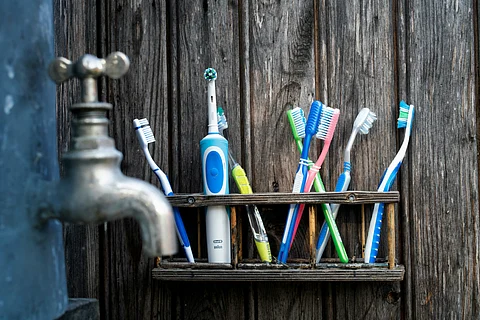A bright, confident smile often starts with a dental implant, but the real magic lies in what comes after. While implants restore function and appearance, their long-term success heavily depends on proper oral hygiene. One of the most overlooked yet powerful tools in that routine? Your toothbrush. More specifically, your choice between a manual and an electric toothbrush can determine how long your implants stay clean, functional, and beautiful.
Let’s explore why your toothbrush choice matters more than you might think when it comes to keeping your implants and your smile at their best.
The Lifespan of a Dental Implant
Dental implants are designed to be a permanent solution for missing teeth. They consist of a titanium post implanted into the jawbone, which serves as a strong foundation for a crown that mimics the appearance and function of a natural tooth. When placed and cared for properly, implants can last decades.
But longevity doesn’t come automatically. While implants aren’t susceptible to cavities, the surrounding gums and bone still are. Infections such as peri-implantitis a condition similar to gum disease can arise if plaque builds up and is left untreated.
Proper daily maintenance, including consistent brushing, is vital. That’s where the toothbrush comes in, not just as a tool, but as a crucial part of your implant’s defense team.
Reclaim your full life, enjoy your favorite foods, and smile confidently with full-mouth dental implants at Doctors Implants in Dallas, TX and make sure you're brushing right to protect that investment.
Electric Toothbrushes vs. Manual: What’s the Difference?
When comparing electric and manual toothbrushes, efficiency is the biggest differentiator. Electric toothbrushes typically feature oscillating or sonic movements that provide thousands of brush strokes per minute, far more than what you can do by hand.
This increased movement helps remove more plaque, especially in hard-to-reach areas around dental implants. Electric brushes also offer pressure sensors, timers, and specialized modes, which are designed to prevent over-brushing or applying too much force, both of which can irritate the gums or damage the implant site.
In short, electric toothbrushes offer a smarter, safer, and more thorough clean, making them an excellent choice for anyone with dental implants.
How the Wrong Toothbrush Can Damage Your Implants
It’s easy to assume any toothbrush will do, but that’s a risky gamble with implants. Using a toothbrush with hard bristles or brushing too aggressively with a manual brush can cause gum recession, exposing the sensitive areas around your implants.
Missed plaque due to poor technique or worn-out bristles can lead to bacterial buildup, inflammation, and even implant failure. Just like natural teeth, implants need consistent and gentle care to thrive. Choosing the wrong brush, manual or electric, can cost you more than just your smile.
Choosing the Right Electric Toothbrush for Implant Care
Not all electric toothbrushes are created equal, especially when it comes to cleaning around dental implants. Here are some key features to look for:
Soft bristles: Gentle on gums and implant surfaces.
Pressure sensors: Alert you when you’re brushing too hard.
Built-in timers: Ensure you’re brushing for a full two minutes.
Specialized modes: Some brushes offer "sensitive" or "gum care" settings, ideal for implant care.
Popular models from reputable brands often come dentist-recommended and include these features as standard. If you're unsure which model is right for you, consult your dentist for tailored advice.
Maintenance Matters: How to Clean Your Electric Toothbrush
Even the best electric toothbrush won’t help if it’s not well-maintained. Bacteria, toothpaste residue, and moisture can quickly turn your hygiene tool into a breeding ground for germs.
Here’s how to care for it properly:
Rinse the brush head thoroughly after every use.
Let it air-dry in an upright position, avoiding enclosed containers.
Replace the brush head every 3 months, or sooner if bristles fray.
Wipe the handle clean regularly to avoid buildup near charging points.
Learn more about electric toothbrush maintenance from Fresh Dental and ensure your tool stays as clean as your smile.
Best Brushing Practices for Implant Longevity
Your brushing routine plays a critical role in how well your implants hold up over time. Here’s how to brush like a pro:
Brush twice daily using gentle circular motions.
Spend at least two minutes brushing each time.
Use an antibacterial mouthwash to rinse away harmful bacteria.
Include interdental brushes or floss designed for implants to clean between teeth.
Schedule regular dental check-ups to ensure your implants remain in top condition.
Consistency is key. It’s not just about what you use, it’s about how you use it.
Confidence Starts with Cleanliness
Oral health isn’t just physical, it’s emotional too. Clean implants support a radiant smile, fresh breath, and the confidence to laugh, speak, and eat without hesitation. When you maintain your dental implants properly, you’re not just taking care of your teeth, you’re investing in your self-esteem and overall wellness.
And yes, it really does all start with your toothbrush.
Conclusion
Your toothbrush might seem like a simple tool, but when you have dental implants, it becomes one of the most important pieces in your oral health toolkit. With the right brush and proper care, you can protect your implants, avoid costly complications, and enjoy a clean, confident smile for years to come.
So the next time you reach for your toothbrush, ask yourself: Is this doing enough for my implants? If not, it might be time to upgrade and brush smarter, not harder.


